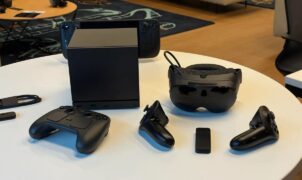TECH NEWS – A new development in haptic holograms brings us one step closer to realistic experiences.
The idea of haptic holograms is familiar to millions from their appearance in sci-fi favourites such as the Star Trek holodeck, where characters can interact with solid-looking computer simulations of people, objects and places. A team of engineers from the University of Glasgow has developed a new way to create physical interaction with holographic projections.
In a new paper published in the journal Advanced Intelligent Systems, the team describes how they developed ‘aerohaptics’. The system pairs volumetric display technology with precisely controlled air jets to create a sense of touch on users’ hands, fingers and wrists. The technique could form the basis for new ways of interacting with virtual objects, advanced forms of teleconferencing and even enable surgeons to perform procedures remotely.
The system, developed by the university’s Bendable Electronics and Sensing Technologies (BEST) research group, is based on a pseudo-holographic display that uses glass and mirrors to superimpose a two-dimensional image as if it were floating in space – a modern version of the 19th century illusion technique known as Pepper’s ghost. Then a Leap Motion sensor is paired to track users’ hand movements with a movable air blower that directs airflow to the palm and fingertips.
In the paper, the team shows how they used the system to create the realistic feel of a basketball bouncing. By displaying a computer-generated 3D image of the basketball in space and using the Leap Motion sensor to track the movement and position of the user’s hand, the system changes the direction and force of the airflow to generate aero-haptic feedback.
The feedback is also modified based on the virtual surface of the basketball, so users can “feel” the rounded shape of the ball as it rolls off their fingertips when bounced and the impact of the ball against their palm when it returns. Users can even “nudge” the virtual ball with different forces and feel the resulting change in the way they think the hard or soft bounce in the palm of their hand.
Other universities are also working on developing holographic technologies, such as the University of Florida:
Beyond touch: heat and smell
Professor Ravinder Dahiya of the James Watt School of Engineering at the University of Glasgow leads the Bendable Electronics and Sensing Technologies (BEST) group developing the system. Professor Dahiya said, “Haptic feedback and volumetric display technology has come a long way in recent years, bringing us closer to being able to interact convincingly with virtual objects. “However, current haptic technology often still involves wearable or hand-held peripherals that are costly and complex, which could hinder the widespread adoption of the technology.
“Aerohaptics creates a compelling sense of physical interaction on users’ hands at a relatively low cost. We are already looking at adding additional features to the system, such as temperature control of their airflow, to deepen the sensation of interaction with hot or cool objects. We believe that aerohaptics could form the basis for several new applications in the future, such as creating compelling, interactive 3D representations of real people for teleconferencing. It could help surgeons perform tricky procedures in virtual space during their training or even allow them to command robots to perform real-life surgeries. We look forward to exploring the possibilities as we continue to develop the system,” added the professor.
The team’s paper, “Pseudo-hologram with Aerohaptic feedback for Interactive Volumetric Displays“, has been published in Advanced Intelligent Systems. The research was funded by the Engineering and Physical Sciences Research Council (EPSRC).
Source: University of Glasgow
















Leave a Reply